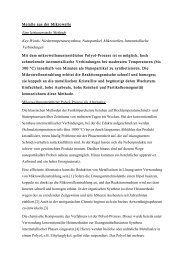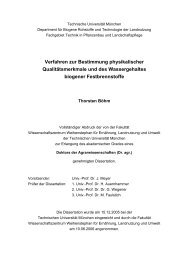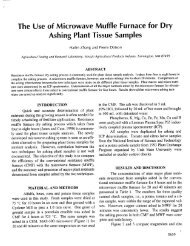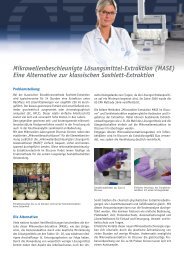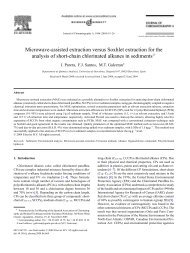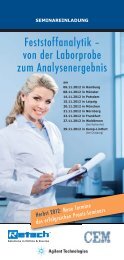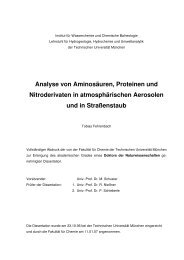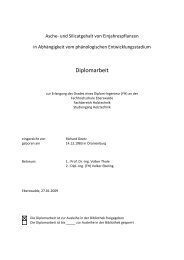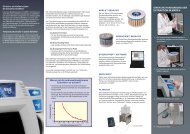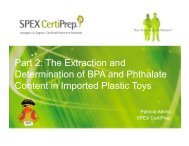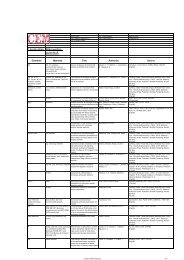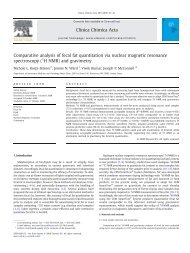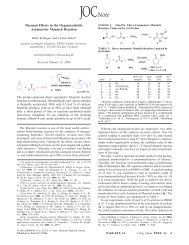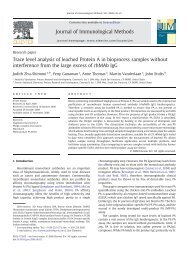A Simple Continuous Flow Microwave Reactor
A Simple Continuous Flow Microwave Reactor
A Simple Continuous Flow Microwave Reactor
Create successful ePaper yourself
Turn your PDF publications into a flip-book with our unique Google optimized e-Paper software.
A <strong>Simple</strong> <strong>Continuous</strong> <strong>Flow</strong> <strong>Microwave</strong><br />
<strong>Reactor</strong><br />
Mark C. Bagley,* ,† Robert L. Jenkins, †<br />
M. Caterina Lubinu, † Christopher Mason, ‡ and<br />
Robin Wood* ,§<br />
School of Chemistry, Main Building, Cardiff University,<br />
Park Place, Cardiff, CF10 3AT, United Kingdom,<br />
CEM <strong>Microwave</strong> Technology Ltd, 2 Middle Slade,<br />
Buckingham, MK18 1WA, United Kingdom, and<br />
AstraZeneca R&D, Alderley Park, Macclesfield,<br />
Cheshire, SK10 4TF, United Kingdom<br />
bagleymc@cf.ac.uk; robinwood@astrazeneca.com<br />
Received May 23, 2005<br />
A new simple procedure for microwave-assisted organic<br />
synthesis under continuous flow processing has been developed<br />
for use in a monomodal microwave synthesizer with<br />
direct temperature control using the instrument’s in-built<br />
IR sensor. This design makes optimum use of the standing<br />
wave cavity to improve the energy efficiency of microwaveassisted<br />
flow reactions.<br />
<strong>Microwave</strong>-assisted organic synthesis (MAOS) has<br />
received increasing attention in recent years as a valuable<br />
alternative to the use of conductive heating for<br />
accelerating chemical reactions. 1 With no direct contact<br />
between the chemical reactants and the energy source,<br />
microwave-assisted chemistry is energy efficient, provides<br />
fast heating rates and enables rapid optimization<br />
of procedures. From the early experiments in domestic<br />
ovens 2 to the use of multimodal 3 or monomodal 4 instruments<br />
designed for organic synthesis, this technology has<br />
been implemented worldwide and continues to be devel-<br />
† Cardiff University. Phone: +44-29-2087-4029. Fax: +44-29-2087-<br />
4030.<br />
‡ CEM <strong>Microwave</strong> Technology Ltd. Phone: +44-12-8082-2873. Fax<br />
+44-12-8082-2342.<br />
§ AstraZeneca R&D.<br />
(1) (a) Adam, D. Nature 2003, 421, 571. (b) In <strong>Microwave</strong>s in Organic<br />
Synthesis; Loupy, A.; Wiley-VCH: Weinheim, Germany, 2002.<br />
(2) (a) Gedye, R.; Smith, F.; Westaway, K.; Ali, H.; Baldisera, L.;<br />
Laberge, L.; Rousell, J. Tetrahedron Lett. 1986, 27, 279. (b) Giguere,<br />
R. J.; Bray, T. L.; Duncan, S. M.; Majetich, G. Tetrahedron Lett. 1986,<br />
27, 4945.<br />
(3) Raner, K. D.; Strauss, C. R.; Trainor, R. W.; Thorn, J. S. J. Org.<br />
Chem. 1995, 60, 2456.<br />
(4) Loupy, A.; Petit, A.; Hamelin, J.; Texier-Boullet, F.; Jacquault,<br />
P.; Mathé, D. Synthesis 1998, 1213.<br />
10.1021/jo0510235 CCC: $30.25 © 2005 American Chemical Society<br />
Published on Web 07/23/2005<br />
oped. 5 However, although modern monomodal instruments<br />
dedicated for MAOS are very successful in smallscale<br />
operations, efforts to process this technology in<br />
continuous flow (CF) reactors are frustrated by the<br />
physical limitations of microwave heating, with a penetration<br />
depth of only a few centimeters and the limited<br />
dimensions of the standing wave cavity. Current technology<br />
has attempted to overcome these obstacles with<br />
conventional instruments by the use of CF reactors that<br />
pump the reagents through a small heated coil that winds<br />
in and out of the cavity, 6 with external temperature<br />
monitoring using a fiber optic sensor, although alternative<br />
methods, such as using a multimode batch 3,7 or CF<br />
reactor, 8 have also been described. We now wish to report<br />
our new method for carrying out MAOS under CF<br />
processing using a commercially available monomodal<br />
microwave synthesizer.<br />
The principal design of our flow cell featured the need<br />
to make optimum use of the cavity and to be able to<br />
monitor the temperature of the flow cell directly using<br />
the instrument’s in-built IR sensor. To this end, a<br />
standard pressure-rated glass tube (10 mL) fitted with<br />
a custom built steel head was filled with sand (∼10 g)<br />
between two drilled frits (Figure 1) to minimize dispersion<br />
and effectively create a lattice of microchannels,<br />
charged with solvent (∼5 mL volume), sealed using PTFE<br />
washers and connected to an HPLC flow system with a<br />
back-pressure regulator (Figure 2). The flow cell was<br />
inserted into the cavity of a self-tunable monomodal<br />
microwave synthesizer, irradiated, and stabilized at the<br />
required reaction temperature through moderation of<br />
microwave power before the introduction of reagents into<br />
the reactor. This system possessed a number of advantages<br />
over commercially available coils, including simple<br />
measurement of the flow cell temperature, no additional<br />
and expensive equipment required short of an HPLC<br />
pump, and the potential to carry out heterogeneous as<br />
well as homogeneous reactions simply by immobilizing<br />
a catalyst on the support in the glass tube.<br />
The cell was first tested in two well-precedented<br />
microwave-assisted reactions operating under continuous<br />
flow (CF) processing, the hydrolysis of chloromethyl-<br />
(5) Reviews on MAOS include: (a) Kappe, C. O. Angew. Chem., Int.<br />
Ed. 2004, 43, 6250. (b) Hayes, B. L. Aldrichim. Acta 2004, 37, 66. (c)<br />
Kuhnert, N. Angew. Chem., Int. Ed. 2002, 41, 1863. (d) Lidström, P.;<br />
Tierney, J.; Wathey, B.; Westman, J. Tetrahedron 2001, 57, 9225. (e)<br />
Loupy, A.; Petit, A.; Hamelin, J.; Texier-Boullet, F.; Jacquault, P.;<br />
Mathé, D. Synthesis 1998, 1213. (f) Gabriel, C.; Gabriel, S.; Grant, E.<br />
H.; Halstead, B. S. J.; Mingos, D. M. P. Chem. Soc. Rev. 1998, 27, 213.<br />
(g) Galema, S. A. Chem. Soc. Rev. 1997, 26, 233. (h) Caddick, S.<br />
Tetrahedron 1995, 51, 10403. (i) Strauss, C. R.; Trainor, R. W. Aust.<br />
J. Chem. 1995, 48, 1665.<br />
(6) http://www.cemsynthesis.com.<br />
(7) Stadler, A.; Yousefi, B. H.; Dallinger, D.; Walla, P.; Van der<br />
Eycken, E.; Kaval, N.; Kappe, C. O. Org. Process Res. Dev. 2003, 7,<br />
707.<br />
(8) (a) Cablewski, T.; Faux, A. F.; Strauss, C. R. J. Org. Chem. 1994,<br />
59, 3408. (b) Kabza, K. G.; Chapados, B. R.; Gestwicki, J. E.; McGrath,<br />
J. L. J. Org. Chem. 2000, 65, 1210. (c) Khadilkar, B. M.; Madyar, V.<br />
R. Org. Process Res. Dev. 2001, 5, 452. (d) Esveld, E.; Chemat, F.; van<br />
Haveren, J. Chem. Eng. Technol. 2000, 23, 279. (e) Esveld, E.; Chemat,<br />
F.; van Haveren, J. Chem. Eng. Technol. 2000, 23, 429. (f) Shieh, W.-<br />
C.; Dell, S.; Repiè, O. Tetrahedron Lett. 2002, 43, 5607.<br />
J. Org. Chem. 2005, 70, 7003-7006 7003
FIGURE 1. <strong>Flow</strong> cell schematic.<br />
FIGURE 2. Schematic diagram of the CF reactor.<br />
thiazole 1 to give hydrochloride 2 9 and a Fischer indole<br />
synthesis 10 of 4 from hydrazine 3 and cyclohexanone in<br />
acetic acid, in both cases using sand as the packing agent.<br />
Under these conditions efficient conversions were achieved<br />
at 150 °C, processing 1gin15-30 min, to give alcohol 2<br />
and indole 4 in 85% and 91% yield, respectively (Scheme<br />
1).<br />
Following the success of these flow reactions, efforts<br />
were made to develop a new microwave-assisted process<br />
(9) For comparison, a solution of 1‚HCl (170 mg, 1.0 mmol) in H2O<br />
(2 mL) was irradiated at 150 °C in a sealed glass tube (150 W) for 10<br />
min and evaporated in vacuo to give 2‚HCl (151 mg, >98%). Comparable<br />
conductive heating procedures carried out at 150 °C in a sealed<br />
tube for 12 min, or at reflux for 30 min, gave thiazole 2‚HCl (90% or<br />
85%, respectively, by HPLC). For related hydrolysis experiments using<br />
conductive heating, see: (a) Houssin, R.; Pommery, J.; Salauen, M.-<br />
C.; Deweer, S.; Goossens, J.-F.; Chavatte, P.; Henichart, J.-P. J. Med.<br />
Chem. 2002, 45, 533. (b) Hagen, S. E.; Domagala, J.; Gajda, C.;<br />
Lovdahl, M.; Tait, B. D.; Wise, E.; Holler, T.; Hupe, D.; Nouhan, C.;<br />
Urumov, A.; Zeikus, G.; Zeikus, E.; Lunney, E. A.; Pavlovsky, A.;<br />
Gracheck, S. J.; Saunders: J.; VanderRoest, S.; Brodfuehrer, J. Med.<br />
Chem. 2001, 44, 2319.<br />
(10) For comparison, a solution of cyclohexanone (196 mg, 2 mmol)<br />
and 3 (220 mg, 2.2 mmol) in AcOH (4 mL) was irradiated at 150 °C in<br />
a sealed glass tube (150 W) for 10 min and then evaporated in vacuo.<br />
The residue was extracted with EtOAc, washed with H2O, aqueous<br />
NaHCO3 solution (2 N) and brine, dried (MgSO4), and evaporated in<br />
vacuo to give 4 (212 mg, 62%), mp 113-115 °C. The comparable<br />
conductive heating procedure carried out at 150 °C in a sealed tube<br />
for 10 min gave 4 (94%), mp 115-117 °C, after purification by column<br />
chromatography on SiO2 eluting with light petroleum-EtOAc (9:1).<br />
For related Fischer indole syntheses, see: (a) An, J.; Bagnell, L.;<br />
Cablewski, T.; Strauss, C. R.; Trainor, R. W. J. Org. Chem. 1997, 62,<br />
2505. (b) Robinson, B. Chem. Rev. 1969, 69, 227. (c) Hughes, D. L.<br />
Org. Prep. Proced. Int. 1993, 25, 607. (d) Franco, L. H.; Palermo, J. A.<br />
Chem. Pharm. Bull. 2003, 51, 975. (e) Lipin’ska, T. Chem. Heterocycl.<br />
Compd. 2001, 37, 231. (f) Lipin’ska, T.; Guibe-Jampel, E.; Petit, A.;<br />
Loupy, A. Synth. Commun. 1999, 29, 1349.<br />
7004 J. Org. Chem., Vol. 70, No. 17, 2005<br />
SCHEME 1. MW-Assisted CF Reactions<br />
for the synthesis of pyridines based upon the Bohlmann-<br />
Rahtz (B-R) 11 reaction. The cyclodehydration of aminodienone<br />
5 can be effected using conductive heating, 12 and<br />
with a Lewis 13 or Brønsted 14 acid catalyst, to give 2,3,6trisubstituted<br />
pyridine 6 directly and with total regiocontrol,<br />
and this transformation has been applied in the<br />
synthesis of pyridine-containing thiopeptide antibiotics, 15<br />
and their derivatives, 16 as well as pyrido[2,3-d]pyrimidines,<br />
17 heterocyclic amino acids, 18 nonsteroidal antiinflammatory<br />
agents, 19 and combinatorial pyridine libraries.<br />
20 Aminodienone 5 was prepared according to known<br />
procedures 12 and cyclodehydrated with CF processing<br />
under homogeneous conditions in toluene-acetic acid (5:<br />
1) over sand, 21 comparing the results to batch experiments<br />
carried out in a sealed tube and to the corresponding<br />
homogeneous CF process with a Teflon heating coil<br />
(Scheme 2). Under conditions that gave efficient conversion<br />
(>98%) to pyridine 6, the processing rates of material<br />
using our glass tube reactor were considerably higher<br />
(Table 1). Additionally, CF reactions run at the same flow<br />
rate used less magnetron energy in a glass tube than in<br />
the heating coil (Table 1, Figures 3 and 4, and Supporting<br />
Information), demonstrating that a glass tube CF reactor<br />
(11) Bohlmann, F.; Rahtz, D. Chem. Ber. 1957, 90, 2265.<br />
(12) Bagley, M. C.; Brace, C.; Dale, J. W.; Ohnesorge, M.; Phillips,<br />
N. G.; Xiong, X.; Bower, J. J. Chem. Soc., Perkin Trans. 1 2002, 1663.<br />
(13) (a) Bagley, M. C.; Dale, J. W.; Hughes, D. D.; Ohnesorge, M.;<br />
Phillips, N. G.; Bower, J. Synlett 2001, 1523. (b) Bagley, M. C.; Glover,<br />
C.; Merritt, E. A.; Xiong, X. Synlett 2004, 811.<br />
(14) Bagley, M. C.; Dale, J. W.; Bower, J. Synlett 2001, 1149.<br />
(15) (a) Bagley, M. C.; Bashford, K. E.; Hesketh, C. L.; Moody, C. J.<br />
J. Am. Chem. Soc. 2000, 122, 3301. (b) Moody, C. J.; Bagley, M. C.<br />
Chem. Commun. 1998, 2049.<br />
(16) (a) Bagley, M. C.; Dale, J. W.; Xiong, X.; Bower, J. Org. Lett.<br />
2003, 5, 4421. (b) Bagley, M. C.; Chapaneri, K.; Xiong, X. Tetrahedron<br />
Lett. 2004, 45, 6121. (c) Bagley, M. C.; Xiong, X. Org. Lett. 2004, 6,<br />
3401.<br />
(17) (a) Hughes, D. D.; Bagley, M. C. Synlett 2002, 1332. (b) Bagley,<br />
M. C.; Hughes, D. D.; Lloyd, R.; Powers, V. E. C. Tetrahedron Lett.<br />
2001, 42, 6585.<br />
(18) (a) Adamo, M. F. A.; Adlington, R. M.; Baldwin, J. E.; Pritchard,<br />
G. J.; Rathmell, R. E. Tetrahedron 2003, 59, 2197. (b) Adlington, R.<br />
M.; Baldwin, J. E.; Catterick, D.; Pritchard, G. J.; Tang, L. T. J. Chem.<br />
Soc., Perkin Trans. 1 2000, 2311. (c) Baldwin, J. E.; Catterick, D.;<br />
Pritchard, G. J.; Tang, L. T. J. Chem. Soc., Perkin Trans. 1 2000, 303.<br />
(d) Moody, C. J.; Bagley, M. C. Synlett 1998, 361. (e) Bagley, M. C.;<br />
Dale, J. W.; Jenkins, R. L.; Bower, J. Chem. Commun. 2004, 102.<br />
(19) Schroeder, E.; Lehmann, M.; Boettcher, I. Eur. J. Med. Chem.<br />
1979, 14, 309.<br />
(20) (a) Bagley, M. C.; Dale, J. W.; Ohnesorge, M.; Xiong, X.; Bower,<br />
J. J. Comb. Chem. 2003, 5, 41. (b) Bashford, K. E.; Burton, M. B.;<br />
Cameron, S.; Cooper, A. L.; Hogg, R. D.; Kane, P. D.; MacManus, D.<br />
A.; Matrunola, C. A.; Moody, C. J.; Robertson, A. A. B.; Warne, M. R.<br />
Tetrahedron Lett. 2003, 44, 1627.<br />
(21) The glass tube was filled with standard quartz sand, 40-100<br />
mesh, suitable for use in chromatography. When aminodienone 5 was<br />
irradiated in toluene (without acetic acid) in the presence and absence<br />
of sand in a sealed tube, no appreciable difference was observed (13%<br />
versus 5% conversion, respectively), indicating that the sand has a<br />
negligible (if any) effect on the cyclodehydration.
SCHEME 2. Bohlmann-Rahtz Synthesis of 6 a<br />
a Reagents and conditions: (a) 150 W (initial power), sealed<br />
tube, 2 min; (b) 300 W (initial power), CF in Teflon heating coil,<br />
1 mL/min; (c) 300 W (initial power) with simultaneous cooling, 22<br />
CF in a glass tube charged with sand, 1 or 1.5 mL/min.<br />
TABLE 1. Comparing MAOS of Pyridine 6 Using Sealed<br />
Tube or CF Processing<br />
sealed<br />
tubea CF<br />
coilb CF<br />
coilb CF glass<br />
tubec CF glass<br />
tubec isolated yield, % >98 >98 85d >98 >98<br />
residency time, e min 2 5f 3.3f 3 2<br />
flow rate, mL min-1 1 1.5 1 1.5<br />
processing rate,<br />
mmol min-1 0.1 0.15 0.1 0.15<br />
total energy, g kJ 1411 762 850 735<br />
a Batch experiment in a sealed glass tube. b CF processing in a<br />
Teflon heating coil. c CF processing in glass tube reactor charged<br />
with sand. d Based upon 1 H NMR analysis of crude reaction<br />
mixture. e Residency in the microwave cavity. f Residency in the<br />
heating coil. g Energy delivered by the magnetron in a flow<br />
reaction, obtained by integrating the power versus time profile.<br />
FIGURE 3. Reaction profile of the CF heating coil reactor at<br />
1.5 mL min -1 flow rate.<br />
FIGURE 4. Reaction profile of the CF glass tube reactor at<br />
1.5 mL min -1 flow rate.<br />
offers (i) improved heating efficiency, (ii) the potential<br />
for operation on a large scale, (iii) successful transfer from<br />
batch to CF processing, and (iv) improved performance<br />
over commercial Teflon heating coils. A higher processing<br />
rate is possible with a glass tube reactor as a faster flow<br />
rate can be maintained without compromising the reaction<br />
temperature and yield. We have attributed this<br />
observation to be a direct consequence of the improved<br />
heating efficiency for reactions in the glass tube, as<br />
heating coils by design wind in and out of the optimum<br />
space.<br />
In conclusion, a CF microwave reactor has been<br />
developed for use with a monomodal instrument for<br />
homogeneous reactions that enables the direct measurement<br />
of flow cell temperature using an IR sensor and<br />
possesses many advantages over existing CF technology.<br />
The use of this instrumentation in a heterogeneous<br />
process through use of an immobilized catalyst and the<br />
transfer of this processing technology to large-scale<br />
operations on a kilogram scale in an 80 mL cell are now<br />
underway and will be reported in due course.<br />
Experimental Section<br />
<strong>Microwave</strong> Reactions under CF Processing. The flow cell<br />
(see the Supporting Information for flow cell assembly) was<br />
primed with solvent at a given flow rate and stabilized at the<br />
reaction temperature. A flask was charged with the reaction<br />
mixture, which was then passed through the cavity at the given<br />
flow rate, washing with further batches of solvent.<br />
4-Hydroxymethylthiazole (2) Hydrochloride. A solution<br />
of 4-chloromethylthiazole hydrochloride (2.0 g, 12 mmol) in H2O<br />
(20 mL) was irradiated at 150 °C (150 W) in a pressure-rated<br />
glass tube (10 mL) filled with sand (∼12 g) in a MW CF reactor<br />
at a flow rate of 1.0 mL min-1 . The cell was washed with H2O<br />
(20 mL) at 150 °C and the combined solutions were evaporated<br />
in vacuo. Purification by recrystallization (Et2O-EtOH) gave the<br />
title compound (1.5 g, 85%) as pale brown crystals, mp 112-<br />
114 °C (lit. 23 mp 115 °C) (found: M•+ , 115.0093; C4H5NOS<br />
requires M 115.0092); 1H NMR (400 MHz, d6-DMSO) δ 9.35 (1H,<br />
s), 8.20-7.70 (2H, br s), 7. 60 (1H, s), 4.65 (2H, s).<br />
2,3,4,9-Tetrahydro-1H-carbazole (4). A solution of cyclohexanone<br />
(1.96 g, 20 mmol) and phenylhydrazine (2.20 g, 22<br />
mmol) in glacial AcOH (40 mL) was irradiated at 150 °C (150<br />
W) in a pressure-rated glass tube (10 mL) filled with sand (∼12<br />
g) in a MW CF reactor at a flow rate of 0.5 mL min-1 . The cell<br />
was washed with AcOH (15 mL) at 150 °C and the combined<br />
solutions were evaporated in vacuo. The residue was extracted<br />
with EtOAc, washed with H2O and brine, dried (MgSO4), and<br />
evaporated in vacuo. Purification by recrystallization (EtOAchexane)<br />
gave the title compound (3.1 g, 91%) as pale beige<br />
crystals, mp 114-116 °C (lit. 24 mp 115-116 °C) (found: M•+ ,<br />
171.1057; C12H13N requires M 171.1048); 1H NMR (400 MHz,<br />
d6-DMSO) δ 10.56 (1H, s), 7.30 (1H, d, J ) 7 Hz), 7.20 (1H, d, J<br />
) 8 Hz), 6.96 (app t, 1H, J ) 7 Hz), 6.89 (1H, app t, J ) 8 Hz),<br />
2.68 (2H, t, J ) 5.7 Hz), 2.60 (2H, t, J ) 6.0 Hz), 1.86-1.74<br />
(4H).<br />
Ethyl 2-Methyl-6-phenylpyridine-3-carboxylate (6):<br />
Batch Synthesis in a Sealed Tube. A solution of aminodienone<br />
511,12 (80 mg, 0.3 mmol) in PhMe-AcOH (5:1) (3 mL)<br />
was irradiated for 2 min at 100 °C (150 W) in a sealed pressurerated<br />
glass tube. The reaction mixture was cooled by a flow of<br />
compressed air then partitioned between saturated aqueous<br />
NaHCO3 and EtOAc, and the aqueous layer was further<br />
extracted with EtOAc. The combined organic extracts were<br />
washed with brine, dried (MgSO4), and evaporated in vacuo to<br />
give the title compound (75 mg, >98%) as a yellow oil. CF<br />
Synthesis in a Heating Coil <strong>Reactor</strong>. A solution of aminodienone<br />
5 (1.3 g, 5.1 mmol) in PhMe-AcOH (5:1) (50 mL) was<br />
irradiated at 100 °C (300 W) in a Teflon heating coil in a MW<br />
CF reactor at a flow rate of 1 mL min-1 and quenched in a<br />
(22) With simultaneous cooling, IR temperature measurement may<br />
not record the accurate bulk temperature of the reaction mixture;<br />
see: Leadbeater, N, E.; Pillsbury, S. J.; Shanahan, E.; Williams, V. A.<br />
Tetrahedron 2005, 61, 3565.<br />
(23) Houssin, R.; Pommery, J.; Salaün, M.-C.; Deweer, S.; Goossens,<br />
J.-F.; Chavatte, P.; Hénichart, J.-P. J. Med. Chem. 2002, 45, 533.<br />
(24) Rogers, C. V.; Corson, B. B. Organic Syntheses; Wiley: New<br />
York, 1963; Collect. Vol. IV, p 884.<br />
J. Org. Chem, Vol. 70, No. 17, 2005 7005
solution of saturated aqueous NaHCO3. The mixture was<br />
extracted three times with EtOAc and the organic extracts were<br />
combined, dried (MgSO4), and evaporated in vacuo to give the<br />
title compound (1.2 g, >98%) as a yellow solid. CF Synthesis<br />
in a Glass Tube <strong>Reactor</strong>. A solution of aminodienone 5 (80<br />
mg, 0.3 mmol) in PhMe-AcOH (5:1) (3 mL) was irradiated at<br />
100 °C (300 W) in a pressure-rated glass tube (10 mL) filled with<br />
sand (∼12 g) in a MW CF reactor at a flow rate of 1.5 mL min -1 ,<br />
while simultaneously cooling the tube in a flow of compressed<br />
air. 22 The mixture was quenched immediately in a solution of<br />
saturated aqueous NaHCO3 and extracted with EtOAc. The<br />
organic extract was dried (MgSO4) and evaporated in vacuo to<br />
give the title compound (75 mg, >98%) as a yellow solid, mp<br />
44-45 °C (MeOH) (lit. 11 mp 44 °C) (found: C, 74.4; H, 6.5; N,<br />
5.6l calcd for C15H15NO2: C, 74.7; H, 6.3; N, 5.8) (found: MH + ,<br />
242.1182; C15H15NO2 requires MH 242.1182); IR (KBr) νmax 2980,<br />
2925, 2890, 1717, 1581, 1476, 1277, 1090, 1022 cm -1 ; 1 H NMR<br />
(400 MHz, CDCl3) δ 8.19 (1H, d, J ) 8.2 Hz), 8.00 (2H, m), 7.55<br />
(1H, d, J ) 8.2 Hz), 7.41 (3H), 4.33 (2H, q, J ) 7.1 Hz), 2.85<br />
7006 J. Org. Chem., Vol. 70, No. 17, 2005<br />
(3H, s), 1.35 (3H, t, J ) 7.1 Hz); 13 C NMR (100 MHz, CDCl3) δ<br />
165.7 (C), 159.1 (C), 158.1 (C), 138.5 (CH), 137.6 (C), 128.7 (CH),<br />
128.0 (CH), 126.5 (CH), 122.8 (C), 116.5 (CH), 60.3 (CH2), 24.6<br />
(Me), 13.5 (Me); MS (APcI) m/z (rel intensity) 241 (M + , 91%),<br />
240 (69), 212 (32), 196 (100), 195 (98), 168 (43), 167 (40).<br />
Acknowledgment. We thank the EPSRC (award to<br />
M. C. Lubinu) and the Royal Society for their generous<br />
support.<br />
Supporting Information Available: General experimental<br />
procedures, diagrams and photographs of apparatus,<br />
instructions for assembly, and all power/temperature versus<br />
time flow reaction profiles for the synthesis of pyridine 6. This<br />
material is available free of charge via the Internet at<br />
http://pubs.acs.org.<br />
JO0510235



